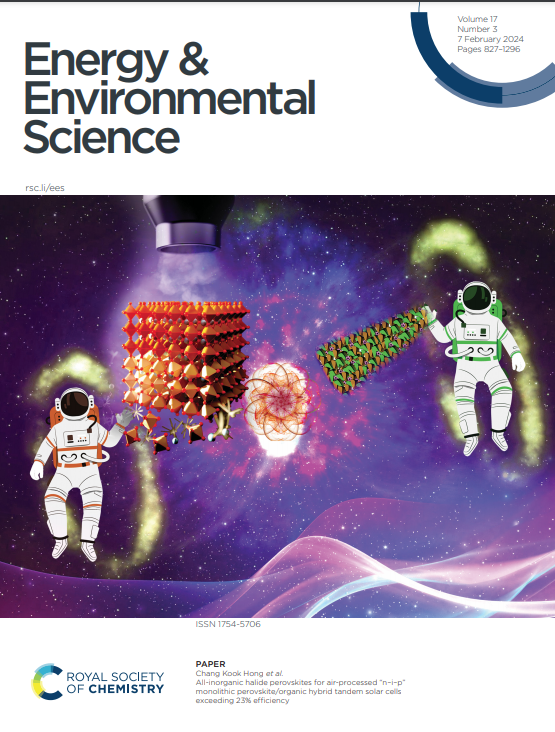具有多重交联网络的刚柔协同聚合物介质用于高温静电储能
IF 30.8
1区 材料科学
Q1 CHEMISTRY, MULTIDISCIPLINARY
引用次数: 0
摘要
高温电介质储能材料是在极端环境下运行的下一代电力电子和电气系统必不可少的材料。然而,在超高温(例如200°C)下实现聚合物介质的高能存储仍然是一个关键的挑战,主要是由于分子链热运动的显著增强,这会导致电荷传导损失增加和击穿强度降低。在这里,我们提出了一种刚性-柔性协同多交联网络策略,同时抑制链间/链内电荷传输,同时抑制热分子运动。这种刚性交联结构支持相邻的聚合物链,增强了局部节段稳定性,同时也减少了链间π-π堆叠和偶极子相互作用。此外,通过柔性段的热力学退火,均匀分布的链间刚性支架在局部结构刚度和全局变形性之间取得了平衡,从而有效地减轻了体电荷传导,提高了极端条件下的储能能力。该材料在200°C下表现出优异的储能性能,放电能量密度为6.91 J cm-3,效率为90%。此外,它还表现出出色的循环稳定性,在500 MV m-1的充放电循环中保持超过50,000次的性能。本研究提出了一种新的高温介质材料设计策略,展示了多重交联结构在满足超高温应用要求方面的潜力。本文章由计算机程序翻译,如有差异,请以英文原文为准。
Rigid-Flexible Synergized Polymer Dielectrics with Multiple Crosslinking Networks for High-Temperature Electrostatic Energy Storage
High-temperature dielectric energy storage materials are essential for next-generation power electronics and electrical systems operating in extreme environments. However, achieving high-energy storage in polymer dielectrics at ultrahigh temperatures (e.g., 200°C) remains a critical challenge, chiefly owing to the marked enhancement of molecular chain thermal motion, which gives rise to elevated charge conduction losses and diminished breakdown strength. Here, we propose a rigid-flexible synergistic multiple crosslinked network strategy that simultaneously suppresses inter/intra-chain charge transport while inhibiting thermal molecular motion. This rigid crosslinked architecture supports adjacent polymer chains, enhancing local segmental stability while also reducing interchain π-π stacking and dipole interactions. Further, enabled by the thermodynamic annealing of flexible segments, the homogenously distributed interchain rigid scaffolds strike a balance between local structural rigidity and global deformability, thereby efficiently mitigating bulk charge conduction and boosting energy storage capabilities under extreme conditions. The resulting material exhibits an exceptional energy storage performance at 200°C, with a discharge energy density of 6.91 J cm-3 at 90% efficiency. Moreover, it demonstrates outstanding cycling stability, maintaining performance over 50,000 charge-discharge cycles at 500 MV m-1. This study presents a new design strategy for high-temperature dielectric materials, showcasing the potential of multiple crosslinked structures to meet the demanding requirements of ultrahigh-temperature applications.
求助全文
通过发布文献求助,成功后即可免费获取论文全文。
去求助
来源期刊

Energy & Environmental Science
化学-工程:化工
CiteScore
50.50
自引率
2.20%
发文量
349
审稿时长
2.2 months
期刊介绍:
Energy & Environmental Science, a peer-reviewed scientific journal, publishes original research and review articles covering interdisciplinary topics in the (bio)chemical and (bio)physical sciences, as well as chemical engineering disciplines. Published monthly by the Royal Society of Chemistry (RSC), a not-for-profit publisher, Energy & Environmental Science is recognized as a leading journal. It boasts an impressive impact factor of 8.500 as of 2009, ranking 8th among 140 journals in the category "Chemistry, Multidisciplinary," second among 71 journals in "Energy & Fuels," second among 128 journals in "Engineering, Chemical," and first among 181 scientific journals in "Environmental Sciences."
Energy & Environmental Science publishes various types of articles, including Research Papers (original scientific work), Review Articles, Perspectives, and Minireviews (feature review-type articles of broad interest), Communications (original scientific work of an urgent nature), Opinions (personal, often speculative viewpoints or hypotheses on current topics), and Analysis Articles (in-depth examination of energy-related issues).
 求助内容:
求助内容: 应助结果提醒方式:
应助结果提醒方式:


